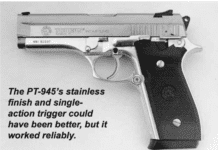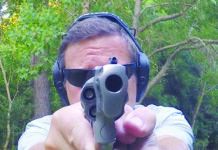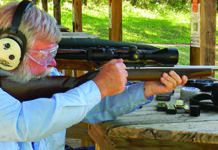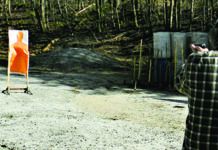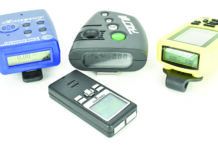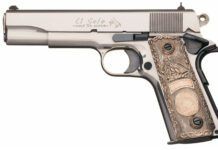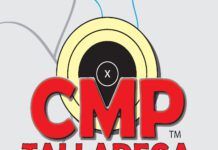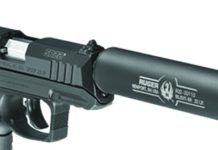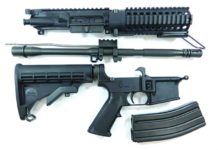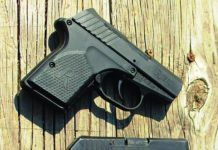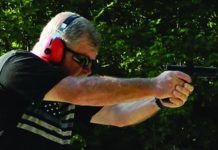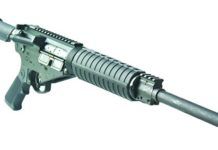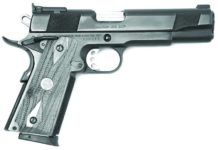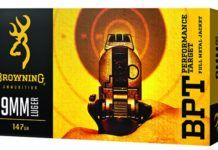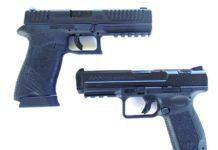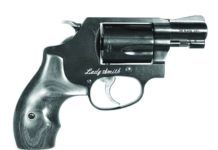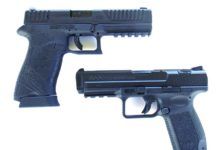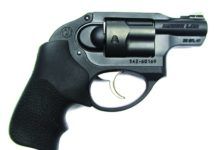380 ACP Loads Update: Choices Are Getting More Interesting
In the October 2010 issue we published a report on 380 ACP defense loads. The work was interesting and reader feedback intensive. During the tests, the loads proved accurate and reliable. The problem was the balance of expansion and penetration. We had either adequate expansion or good penetration but not each in the same loading. Some loads penetrated as little as 9 inches, with the average load at 12-13 inches. Expansion was modest in most cases. As a result, we felt that the full-metal-jacketed non-expanding bullet was a viable choice because there was a chance it would reach vital areas and create a stoppage. Surprisingly, even FMJ loads penetrated but 14 inches in water in that test. So, the search was on for a loading that might offer superior performance to the original test choices.
This time, we tested ten different loads using the same media — water and water jugs — and came away with a couple of loads that showed good promise for personal defense.
Since our initial test, many readers have continued to ask us about the effectiveness of the 380 ACP outside the ability to make highly accurate cranial shots. If the bullet cannot be counted on to reach the vitals, then it would hardly be of much use even if it did expand. However, FMJ loads do not necessarily solve every problem. A lightweight FMJ bullet is far more likely to stop short in penetration than a heavier bullet of moderate velocity. Often, a heavier-for-the-caliber-bullet will penetrate more even at lower velocity.
In our experience, modern shooters tend to look at the 380 as a lighter alternative to the 9mm, but a better comparison is between the 38 Special snubnose and the 380. So, as a point of reference, we included a middle-of-the road 125-grain JHP 38 Special +P load fired from a 2-inch-barrel revolver to represent an average for performance with the 125-grain JHP. It makes a striking example of how the 380 ACP fares against what we believe is at least an adequate 38 Special load. Also, for your convenience, we've listed the performance of the first round of 380 ACP loads we tested six years ago. Also, the top-ranked loads from the first test were the Fiocchi FMJ 95-grain No. 380FMJB and Speer Gold Dot 90-gr. No. 23606.
Ruger Aims to Expand Support For In-House Suppressor Line
Ruger is rolling out additional support for its new line of rimfire suppressors, the Silent-SR 22 line.
The Ruger Silent-SR sound suppressor was designed and built by Ruger utilizing fluid dynamic simulation and computer numeric controlled (CNC) machining equipment. Based on samples we've handled, the Ruger Silent-SR is easy to disassemble and clean. Each piece snaps together to seal the baffles and keep the byproducts of combustion away from the tube and end caps.
It is also strong and light, utilizing a titanium tube, aluminum rear cap, and stainless steel threaded mount, baffles and front cap. It measures 5.37 inches in length, 1.1-inch in diameter, and weighs 6.3 ounces.
Of course, what matters is how it reduces sound pressure levels of 22 LR, 22 WMR and 17 HMR pistols and rifles by up to 40 dB. It features a standard 1⁄2-28 thread pattern for compatibility with most threaded rimfire firearms.
The outer tube and muzzle mount are interlocked to prevent accidental disassembly when removing the suppressor from your firearm. A disassembly tool is included.
Also, Ruger is making it easier to attach the suppressor to your existing SR22 pistol.
The Ruger SR22 Threaded Barrel Kit 90520, $150, is a genuine Ruger factory accessory compatible with Ruger SR22 pistols bearing serial numbers 361-7XXXX and higher.
The threaded barrel accepts any 1⁄2-28 (Class 2A) muzzle device, including the Ruger Silent-SR. This kit contains a factory-manufactured stainless steel barrel for optimal fit and function. Barrel changing is quick and easy with no gunsmithing required, and a barrel cap, adapter, and wrench included. Note that the replacement barrel does not fit the 4.5-inch-length barrel model.
Worth noting: Ruger cannot bill to or ship to the following states and cities: California, Connecticut, Washington DC, New York, and Chicago, IL.
Takedown ARs from DRD, Ruger, Windham: Who Takes the Cake?
Espionage novels and movies are filled with rifles that are transported in a brief case, quickly assembled, then used to fire incredibly accurate shots. But is the ability to transport a disassembled AR in a small case or knapsack more intriguing than practical? Couldn't an AR already be considered a takedown rifle? Can't you just disassemble the lower receiver from the upper receiver and tote the two pieces in a duffle bag? These were a few questions team members had as we started looking into takedown AR-15s.
On one side of the debate, a takedown AR can be discreetly carried without the normal gun case that announces to all what is inside. A takedown AR is something one might consider adding to his bug-out gear should flood, fire, or worse coming knocking on the door. Takedown ARs also have the ability to swap calibers, allowing a user to perhaps opt for 300 AAC Blackout on a pig hunt, use the 5.56mm NATO for home defense, and 9mm for low-cost training. This caliber-swap feature gives these ARs the ability to use whatever ammo is available at the moment. We've all experienced the ammunition shortages of the recent past, and there is no reason to think it won't happen again. These ARs can feed whatever ammo is available. Another plus on the takedown AR side is easier cleaning.
On the other side of the debate, parts that are assembled and reassembled wear faster than parts that are fixed, and the more complicated a design, the more likely it is to break and the harder it is to get spare parts. Also, we wondered how zero might shift when removing then replacing the same-caliber barrel? And, how would a different caliber affect point of impact? Of course, price is always a consideration, and the cost of these takedown ARs is high — more than four times the cost of an entry-level 5.56mm AR priced at about $550. Can't a shooter just buy two rifles and set them up with optics at the same cost or less?
To answer these and other questions, we gathered three models from DRD Tactical, Ruger, and Windham Weaponry. These manufacturers have taken the modularity characteristics of the AR to a new level, each offering its own unique takedown design. Operationally, the DRD and Windham are direct-gas-impingement models; the Ruger uses a piston system.
All in, these takedown rifles get smaller by separating the barrel from the rail, which we estimate as a reduction in length of about 8.5 inches. With all three takedown ARs, the rifle is broken down into three main components. One thing to note: The rails or handguards on these rifles are not compatible with aftermarket parts. You must use the handguard the AR is shipped with because it is a key part of the takedown design. You can, however, customize these ARs with other aftermarket parts like stocks, pistol grips, triggers, sights, controls, muzzle devices, and so on.
380 ACP Shoot Out: Ruger LCP Takes On Remington, Rock Island
New pistols chambered for the 380 ACP continue to flow out of factories because these generally smaller handguns feature reduced recoil firing the 9mm Kurz or 9mm Short, two other dimensionally accurate names for the 380 Auto cartridge. The 380's case is about 2mm shorter than the popular 9mm Luger case, though their bullet diameters are the same. The advantage of chambering ammunition with a short overall length helps keep these guns concealable.
One, the Ruger LCP, has sold in greater numbers than perhaps any other modern 380 ACP pistol, and with good reason, if the results in this magazine are any guide. In the June 2008 issue, we tested a just-released LCP and gave it an A- grade, saying of it, "This gun did what it was designed to do. Perhaps the grips could be more effectively textured, but we'd hate to spoil its looks. The Ruger LCP may be limited in its application, but could prove invaluable in its service." Head to head against the Kel-Tec P3AT, we said that Ruger had basically refined the Kel-Tec, in our view. The checkering on the slightly wider LCP grip frame was finer, which resulted in the Ruger jumping around in the hand more than the Kel-Tec. In that first look eight years ago, we narrowly preferred the Kel-Tec. Then in 2009, Ruger issued a recall for the LCP because the company had received a small number of reports that the gun, "...can discharge when dropped onto a hard surface with a round in the chamber." The company offered a retrofit of a different hammer mechanism to cure the problem, which was offered at no charge to the customer, and the little gun kept on chugging. In the February 2013 issue, we tested a variant of the LCP, the Ruger LCP-LM No. 3718, which mashed together Ruger's tiniest pistol with LaserMax's trigger-guard laser sight. The laser was nicely integrated into the pistol. In that test, we noted, "the female tester in the group had a hard time racking the slide. As pistols get smaller they can be harder to use and operate." We also said, "More seasoned testers did not like that the slide did not lock open on the last shot, like it did with the SIG P238 and Walther PK380." That pistol earned a B+ grade, and Our Team Said, "The Ruger was the best choice for deep-conceal carry" in that test. Then in the October 2015 issue, we tested a Ruger LCP-C Custom No. 3740 against a Taurus Curve and gave the upgraded LCP-C an A grade, saying of it: "We found the Ruger LCP-C Custom to be reliable, accurate enough for personal defense, and compact enough for concealed carry and pocket carry. The sights and trigger are improvements over previous versions of the LCP. The Ruger's footprint is smaller than the Taurus, but the Ruger is lighter and developed more energy." So, clearly, this is a capable, consistent handgun that has survived nearly 10 years because of its merits — simple operation, light weight, reasonable shooting characteristics, and affordability.
Seeking to take some of the LCP's market share, Remington officially introduced the RM380 Micro at the 2015 NRA Annual Meetings and Exhibits. The RM380 is a double-action-only pistol with second-strike capability. It operates from a delayed blowback action and has an aluminum frame. Remington produced an unusual marketing angle for the gun, claiming its slide-racking force was very low. That was something we asked the test team to evaluate in particular.
Also introduced at the 2015 NRA Annual Meetings & Exhibits in Nashville was Armscor's Rock Island Armory Baby Rock 380 ACP 1911 51912, though it had been shown as a prototype as early as the summer of 2014. At introduction, Rock Island President and CEO Martin Tuason called the pistol a "mini 1911" and said it was a single-stack pistol with a seven-round magazine. We previously tested a similar concept (an 85% 1911) in Browning's Black Label 1911-380 in the September 2015 issue, giving it a B ranking. Also in that test was the smaller, but still 1911-style Kimber Micro Carry Advocate Brown, which got an A- grade and was much better in the pocket.
While we conducted accuracy testing with our standard three loads, combat firing and initial break in was accomplished with six different loads. In order of use, they were: Winchester USA 95-grain FMJs, HPR 90-grain JHPs, Fiocchi Shooting Dynamics 90-grain JHPs, Winchester Train & Defend 95-grain FMJs, Gorilla Ammunition 95-grain JHPs, and the Black Hills Ammunition 60-grain Xtreme Defense.
Initial firing was done with Winchester FMJ loads, then we poured more than 100 rounds through each pistol for reliability testing and during combat firing at 5, 7, and 10 yards. Here's how the Ruger LCP, the Remington RM380, and Rock Island Baby Rock did.
Glock Night Sights: We Test Glow-in-the-Dark Aiming Aids
As a carry handgun, the Glock is rugged, reliable, and combat worthy. About the only modifications that actually improve the Glock are the addition of a better trigger and a set of aftermarket sights. We dealt extensively with the issue of trigger replacements in the April 2014. There, we installed a Zev Technologies' GlockWorx Ultimate kit from Brownells.com ($250, #100-006-566WB, Mfr. Part: ZTFULULT4G9BLK) into our Glock 17. We gave the Ultimate Kit an A grade, saying it "was the upgrade that produced the biggest difference in performance all by itself, increasing the accuracy of the Glock 17 from an average grouping of 2.3 inches down to 1.6 inches."
Also in the April 2014 issue, we looked at two sight-upgrade kits, both from Brownells. One was the Brownells Glock 17 Sight Upgrade Kit ($200, #080-000-919WB), which included a Meprolight (Kimber) ML-10224 Tru-Dot Night Sight System for Glock 17, 19, 22, 23, 31, 32, 33, 34, 35, 37, 38, 39; an MGW Glock Sight Adjustment Tool, and an Ed Brown Front Sight Tool for Glock. Since we had the installation tools handy, we also ordered a set of TruGlo tritium fiber-optic Brite-Sites ($90, #902-000-107WB, Mfr. Part: TG131GT1Y), yellow rear and green front. We chose to put the TruGlo sights on the Glock 17 and the Tru-Dots on a G34 so that we could shoot them side by side.
With the Ed Brown Front Sight Tool for Glock ($20 sold separately, #087-017-001WB, Mfr. Part: 952) and the MGW Glock Sight Mover ($100 sold separately, #584-045-017WB, Mfr. Part: MGW309) for the rear sight, we started the switch with a disassembly of the slide to get access to the front sight. With the Ed Brown front sight tool and a small crescent wrench, we loosened the screw beneath the sight and removed it, then replaced the white dot with the new TruGlo front sight and tightened with the crescent wrench. Once the front sight was swapped, we hooked the slide into the MGW. The device came with some thin plates to raise the slide up the right height. We did not need them. The old sight drifted out with relative ease, going left to right pointed away from us. The new rear TruGlo sight did require some minor fitting with a file and a little more strength to slide in, but with the MGW tool, leverage was not a problem. We used the same process to put the Meprolite sights onto a factory Glock 34.
Despite the new TruGlo sights being fixed like the originals, we found them to be much clearer and easier to acquire and reacquire targets. We took to the range with the TruGlo sights installed, using all other original parts, and we cut our average group size down by almost half an inch, from 2.3 inches with the standard Glock to 1.9 inches with the TruGlo sights. We turned down the lights over the shooters, leaving the targets illuminated to check out how much the tritium would glow in the fiber-optic sights. The green front sight was quite bright, while the rear yellow sights were significantly dimmer, although still visible.
The Meprolight Tru-Dots provided an even more impressive change on the G34. We shaved just over a full inch off our average group size at 10 yards once we installed them.
Upgrading fixed sights can seem like a challenge to someone who hasn't done work on pistols previously, but with these tools and the simplicity of Glock's designs, this upgrade is a great place to start if you want to attempt a DIY project. You can drift the sights out with a punch, which will save $100 for the MGW tool, but you risk rupturing the tritium capsules. The MGW mover requires oil on the crankshaft, but it made drifting the dovetail sights in and out so easy we quickly misplaced our punch set. Overall, we found the TruGlo sights to be a nice upgrade and would recommend putting them in place of the standard non-tritium sights on any factory Glock. We gave them a Grade: A ranking, along with the Meprolight Tru-Dot tritium.
Naturally, readers asked about other sights, so we began looking at more replacements we could test head to head, rather than as a general Glock upgrade. So, again working with Brownells, we assembled a sextet of night sights suitable for installation on various Glocks. Also, we believe you can broaden our recommendations to include other firearms of similar size — the visual presentation won't be appreciably different on different platforms — though the installation process may differ gun to gun.
American AK-Mag Variants II: Century, RRA, CMMG Go At It
Last month, we began testing AK-pattern rifles built in the U.S., which itself is important to a lot of Gun Tests readers, but also because we wanted to take an in-depth look at the category of what we hoped might be "improved" domestic variants of this famous rifle. Over the years, we've admired various AKs for their reliability while we've criticized their accuracy, fit and finish, and shooter-experience packages, such as crappy triggers and uncomfortable stocks. That said, we were very pleased with three rifles we tested in the June issue, rating one as a Grade A gun (Palmetto State Armory AK-47 MOE Edition 7.62x39mm, $749), a second as a Grade A- rifle (Century Arms RAS47 Magpul-Zhukov 7.62x39mm, $800), and the third a B+ (Palmetto State Armory AK-47 Gen2 Classic Red 7.62x39mm, $849).
This time we pit what are probably the two most significant military rifle actions of the 20th century against each other, the Kalashnikov and the Stoner. But there is a twist: All four rifles are American made, are chambered in 7.62x39, and use Kalashnikov-pattern magazines. The two Kalashnikov actions are made by Century Arms and look very much like standard AK-pattern rifles. The two Stoner actions, made by Rock River Arms and CMMG, for the most part look like the AR-15 platform familiar to many shooters but have some unique features. The Kalashnikovs have a well-deserved reputation for reliability, and the Stoners have a well-deserved reputation for accuracy. So, how would they do head to head?
To find out, we fired all four rifles in both cold and hot conditions, and because we expect these rifles to be used both as plinkers and for hunting or rural self defense, we used four different types of ammunition for this test: 122-grain FMJs, 123-grain plastic-tipped hollowpoints, 124-grain soft points, and 154-grain soft points. Due to the fairly big groups shot with open sights at 100 yards last time, this round we fired five-shot groups at 50 yards and measured them from center to center. Here's what we learned.
More Laments for Custom Guns
Like Grant said in last month's letters section, I, too, lament the passing of the pride of custom-gun ownership and the common look of the Ubiquitous Black Gun. But, as was said, black guns are cheap and proven reliable. Also, I cannot justify carrying a nice custom pistol on the off chance that I might have to use it. In that case, I would have to surrender it to the police, and then it would be months at a minimum to maybe get it back by jumping through their hoops.
Yes, I would rather carry a "Rolex"-quality sidearm, but I often think that if I had to give up my Valtro, I'd don't know what I'd do.
A black gun I can give up with no emotion, and go home and get another one. I always enjoy the magazine, from the editorial remarks to the last page. — Dave
New Handguns at SHOT Las Vegas 2016
At the 2016 SHOT Show in Las Vegas, Gun Testsstaffers ran across many dozens of new products that we're working to include in future tests. Following are some of the handguns, handgun ammunition, and handgun accessories we were interested in. Next month we'll look at new long guns and new options for them.
Given the growth of the AR-15 pistol market, aftermarket supplier ATI sees an opportunity to help users of the popular Ruger Charger get more enjoyment out of its use. The AR-22 Pistol Stock System features a polymer receiver chassis and a T2 pistol grip as well as a six-sided aluminum free-floating forend that sports an FS8 nose cone. The T2-style pistol grip lowers a shooter's hand to align the finger with the trigger, and the sure-grip texture helps reduce recoil. In addition, the stock also features a 16-inch aluminum Picatinny rail that runs the length of the receiver and forend for trouble-free optic and accessory mounting.
The biggest ammunition surprise might be the news that Browning is now offering, via licensing, a full line of ammunition manufactured by Olin-Winchester.
The BXP Personal Defense X-Point defensive handgun loads are loaded in black nickel-plated cases, with bullets utilizing the X-Point technology. There is also a line of Target Performance BPT loads for defensive handguns. The usual chamberings are represented in both lines, with one load each in 380 ACP, 9mm Luger, 40 S&W, and 45 Auto. Browning is also offering rimfire loads in 22 LR. They have a distinct black-oxide coating on the bullet and will be offered in 100- and 400-round packages.
Century Versus Diamondback: Affordable 9mms Butt Heads
The high-capacity 9mm handgun continues to be a popular personal-defense choice, for good reason. Many of the finest handguns in the world are chambered for the 9mm Luger cartridge and nothing else. In a handgun of 30 ounces or so, loaded recoil is light to manageable. Practical accuracy may be outstanding. A magazine capacity of 15 rounds or more is reassuring and gives a good reserve of ammunition. With these considerations in mind, we tested two modern economy-grade 9mm handguns whose performance was acceptable, especially considering the price, though our shooters found we liked one pistol better.
These two handguns are large for concealed carry, but they are light enough and may be concealed with enough effort and an intelligent holster choice. Certainly, they can be employed in the home, where overall size is less of an issue. Those firing and using compact handguns may not realize how easy bigger handguns are to use well compared to a pocket model.
One such larger handgun that is affordable to boot is the Century Arms TP9SA, which is listed in the company's catalog as SKU HG3277-N. A similar desert tan model is HG3277D-N. We found one selling for $346 atBudsgunshop.comand another one on sale at Cabela's for just under $300. This handgun is manufactured by Samsun Yurt Savunma, a Turkish gun maker, and imported by Century Arms of Delray Beach, Florida. The TP9SA and many of its accessories are marked "Canik," for the Canik 55 division of the manufacturer. So, to be plain about it, the Century Arms TP9SA is a Canik 55 9mm pistol, similar in outline to the Smith & Wesson SW99 and Walther P99. There are enough differences between the Canik and the Walther pistol to say the former is not a clone of the latter, but the Century import is obviously similar to a comparable Walther, being a service-size 9mm with a polymer frame and mid-length slide and a 4.25-inch barrel. Our second test gun was the Diamondback Firearms DB FS Nine DB9FS 9mm Luger, which lists for $483, but which we found at Budsgunshop.com selling for $265. Founded in 2009, Diamondback Firearms is based in Cocoa, Florida.
The Diamondback DB9FS is a striker-fired polymer-frame pistol that in general outline resembles the Glock 17. Our shooters noted that the pistol feels different than a Glock, and the overall configuration is markedly different than the Glock. Here's more about these two affordable 9mm pistols.
Revolvers for the Elderly, New Virginia Laws, Henry Rifles
In last month's Firing Line, reader Winslow asks for advice on a 357 magnum lightweight snubnose revolver for a 75-year-old female cousin. I would appreciate a little help. I'm wondering why these two diametrically opposed 308s were chosen to oppose one another. While I am not in one of the affected states, I am from Vermont, and we do not require a permit for CC, and no state recognizes our not needing a permit! Whatever happened to the personal pride everyone took in their ownership of not only a working tool, but also a masterpiece of design and artwork?
I have read recent Gun Tests articles on various AR rifles, so I recently built an AR with a folding stock. I was attracted to this option because I drive a sports car, and even with a collapsible stock and 16-inch barrel, an AR will not fit in the trunk. The folding stock adapter I chose was one made by Law Tactical (LawTactical.com). It was easy to install, works fine to fold the stock, and adds just a little bit of fiddling when I have to separate the upper and lower. But it is very expensive and adds no additional operating functionality to the firearm, since it should never be fired with the stock folded. Anyway, I have not seen many options for folding stocks on an AR platform, and thought that a review of adapters for them might be in order.
Century Versus Diamondback: Affordable 9mms Butt Heads
The high-capacity 9mm handgun continues to be a popular personal-defense choice, for good reason. Many of the finest handguns in the world are chambered for the 9mm Luger cartridge and nothing else. In a handgun of 30 ounces or so, loaded recoil is light to manageable. Practical accuracy may be outstanding. A magazine capacity of 15 rounds or more is reassuring and gives a good reserve of ammunition. With these considerations in mind, we tested two modern economy-grade 9mm handguns whose performance was acceptable, especially considering the price, though our shooters found we liked one pistol better.
These two handguns are large for concealed carry, but they are light enough and may be concealed with enough effort and an intelligent holster choice. Certainly, they can be employed in the home, where overall size is less of an issue. Those firing and using compact handguns may not realize how easy bigger handguns are to use well compared to a pocket model.
One such larger handgun that is affordable to boot is the Century Arms TP9SA, which is listed in the company's catalog as SKU HG3277-N. A similar desert tan model is HG3277D-N. We found one selling for $346 atBudsgunshop.comand another one on sale at Cabela's for just under $300. This handgun is manufactured by Samsun Yurt Savunma, a Turkish gun maker, and imported by Century Arms of Delray Beach, Florida. The TP9SA and many of its accessories are marked "Canik," for the Canik 55 division of the manufacturer. So, to be plain about it, the Century Arms TP9SA is a Canik 55 9mm pistol, similar in outline to the Smith & Wesson SW99 and Walther P99. There are enough differences between the Canik and the Walther pistol to say the former is not a clone of the latter, but the Century import is obviously similar to a comparable Walther, being a service-size 9mm with a polymer frame and mid-length slide and a 4.25-inch barrel. Our second test gun was the Diamondback Firearms DB FS Nine DB9FS 9mm Luger, which lists for $483, but which we found at Budsgunshop.com selling for $265. Founded in 2009, Diamondback Firearms is based in Cocoa, Florida.
The Diamondback DB9FS is a striker-fired polymer-frame pistol that in general outline resembles the Glock 17. Our shooters noted that the pistol feels different than a Glock, and the overall configuration is markedly different than the Glock. Here's more about these two affordable 9mm pistols.
Snubbies, Holsters, Rifles and A Cartridge Shortage
I'm a long-time customer and would like to get three or more comparisons of 357 Magnum lightweight snub-nose revolvers. The index shows the captioned rifle being reviewed in November. When I go online for past reviews, I only find a 2007 review, and it was not from November, as stated in magazine. The Blackhawk GripBreak 421903BK holster seems like just the ticket for this coming year for those of us who are predisposed to reject Kydex and plastic holsters for reasons of them being ugly and inelegant. Problem is, no one has the GripBreaks. Check your Schmidt-Rubin for a possible Christmas present. Remove the buttplate and see if there is anything under it. Many original owners wrote a personal note or ID and hid it under the plate. - Winslow




